Financial Management Report: Financial Analysis of Business Decisions
VerifiedAdded on 2023/01/07
|17
|3750
|53
Report
AI Summary
This report delves into financial management, focusing on mergers, acquisitions, and investment appraisal techniques. It analyzes the valuation of Trojan plc using price/earnings ratio, dividend valuation, and discounted cash flow methods, along with their associated drawbacks. The report recommends the dividend valuation model for Aztec plc's assessment of Trojan plc. Additionally, it evaluates investment appraisal techniques for Love-well plc's potential purchase of new machinery, calculating payback period, accounting rate of return, net present value, and internal rate of return. The report provides recommendations based on these calculations and critically evaluates the benefits and drawbacks of each investment appraisal method, offering a comprehensive overview of financial decision-making processes.

Financial Management
Paraphrase This Document
Need a fresh take? Get an instant paraphrase of this document with our AI Paraphraser
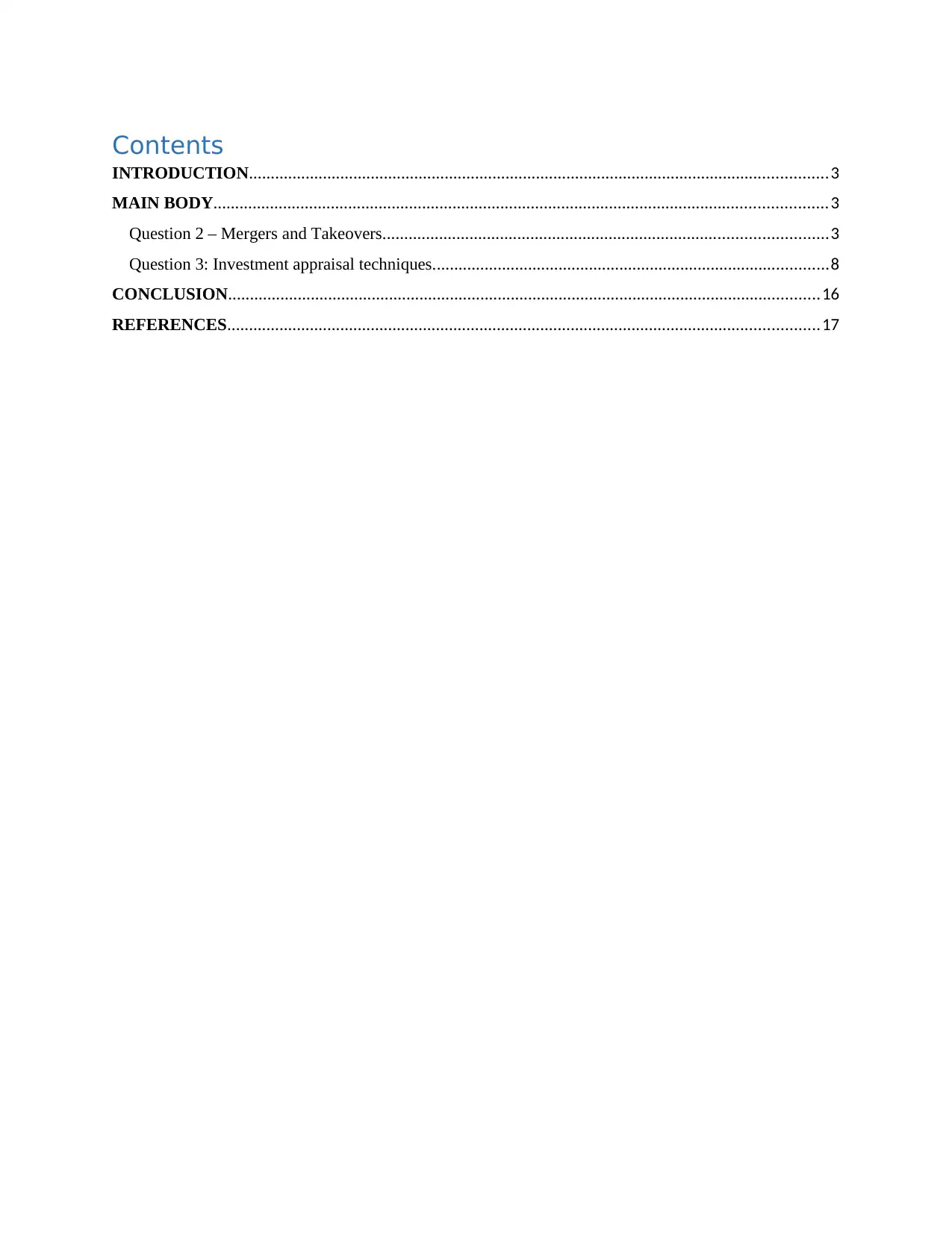
Contents
INTRODUCTION.....................................................................................................................................3
MAIN BODY.............................................................................................................................................3
Question 2 – Mergers and Takeovers......................................................................................................3
Question 3: Investment appraisal techniques...........................................................................................8
CONCLUSION........................................................................................................................................16
REFERENCES........................................................................................................................................17
INTRODUCTION.....................................................................................................................................3
MAIN BODY.............................................................................................................................................3
Question 2 – Mergers and Takeovers......................................................................................................3
Question 3: Investment appraisal techniques...........................................................................................8
CONCLUSION........................................................................................................................................16
REFERENCES........................................................................................................................................17
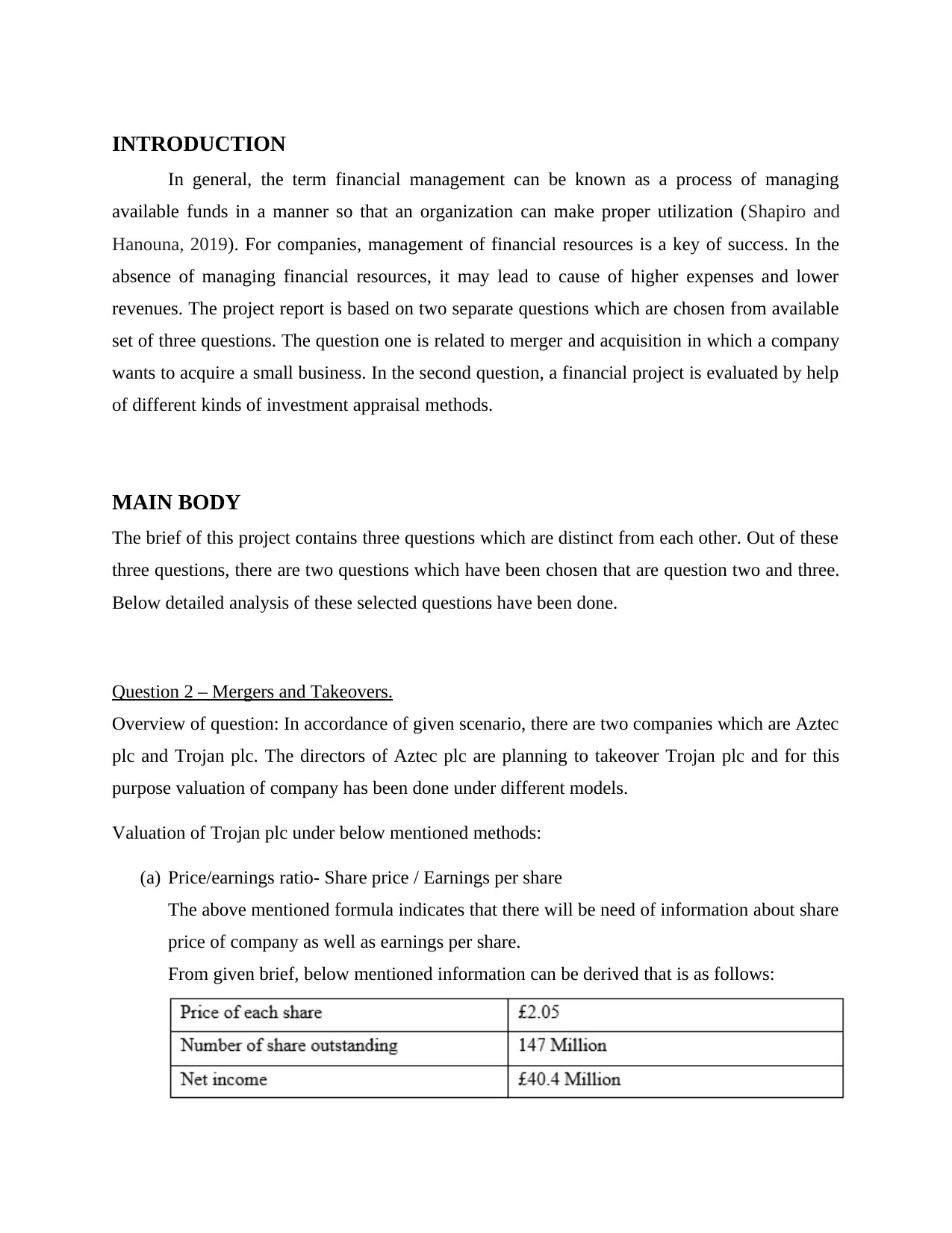
INTRODUCTION
In general, the term financial management can be known as a process of managing
available funds in a manner so that an organization can make proper utilization (Shapiro and
Hanouna, 2019). For companies, management of financial resources is a key of success. In the
absence of managing financial resources, it may lead to cause of higher expenses and lower
revenues. The project report is based on two separate questions which are chosen from available
set of three questions. The question one is related to merger and acquisition in which a company
wants to acquire a small business. In the second question, a financial project is evaluated by help
of different kinds of investment appraisal methods.
MAIN BODY
The brief of this project contains three questions which are distinct from each other. Out of these
three questions, there are two questions which have been chosen that are question two and three.
Below detailed analysis of these selected questions have been done.
Question 2 – Mergers and Takeovers.
Overview of question: In accordance of given scenario, there are two companies which are Aztec
plc and Trojan plc. The directors of Aztec plc are planning to takeover Trojan plc and for this
purpose valuation of company has been done under different models.
Valuation of Trojan plc under below mentioned methods:
(a) Price/earnings ratio- Share price / Earnings per share
The above mentioned formula indicates that there will be need of information about share
price of company as well as earnings per share.
From given brief, below mentioned information can be derived that is as follows:
In general, the term financial management can be known as a process of managing
available funds in a manner so that an organization can make proper utilization (Shapiro and
Hanouna, 2019). For companies, management of financial resources is a key of success. In the
absence of managing financial resources, it may lead to cause of higher expenses and lower
revenues. The project report is based on two separate questions which are chosen from available
set of three questions. The question one is related to merger and acquisition in which a company
wants to acquire a small business. In the second question, a financial project is evaluated by help
of different kinds of investment appraisal methods.
MAIN BODY
The brief of this project contains three questions which are distinct from each other. Out of these
three questions, there are two questions which have been chosen that are question two and three.
Below detailed analysis of these selected questions have been done.
Question 2 – Mergers and Takeovers.
Overview of question: In accordance of given scenario, there are two companies which are Aztec
plc and Trojan plc. The directors of Aztec plc are planning to takeover Trojan plc and for this
purpose valuation of company has been done under different models.
Valuation of Trojan plc under below mentioned methods:
(a) Price/earnings ratio- Share price / Earnings per share
The above mentioned formula indicates that there will be need of information about share
price of company as well as earnings per share.
From given brief, below mentioned information can be derived that is as follows:
⊘ This is a preview!⊘
Do you want full access?
Subscribe today to unlock all pages.

Trusted by 1+ million students worldwide
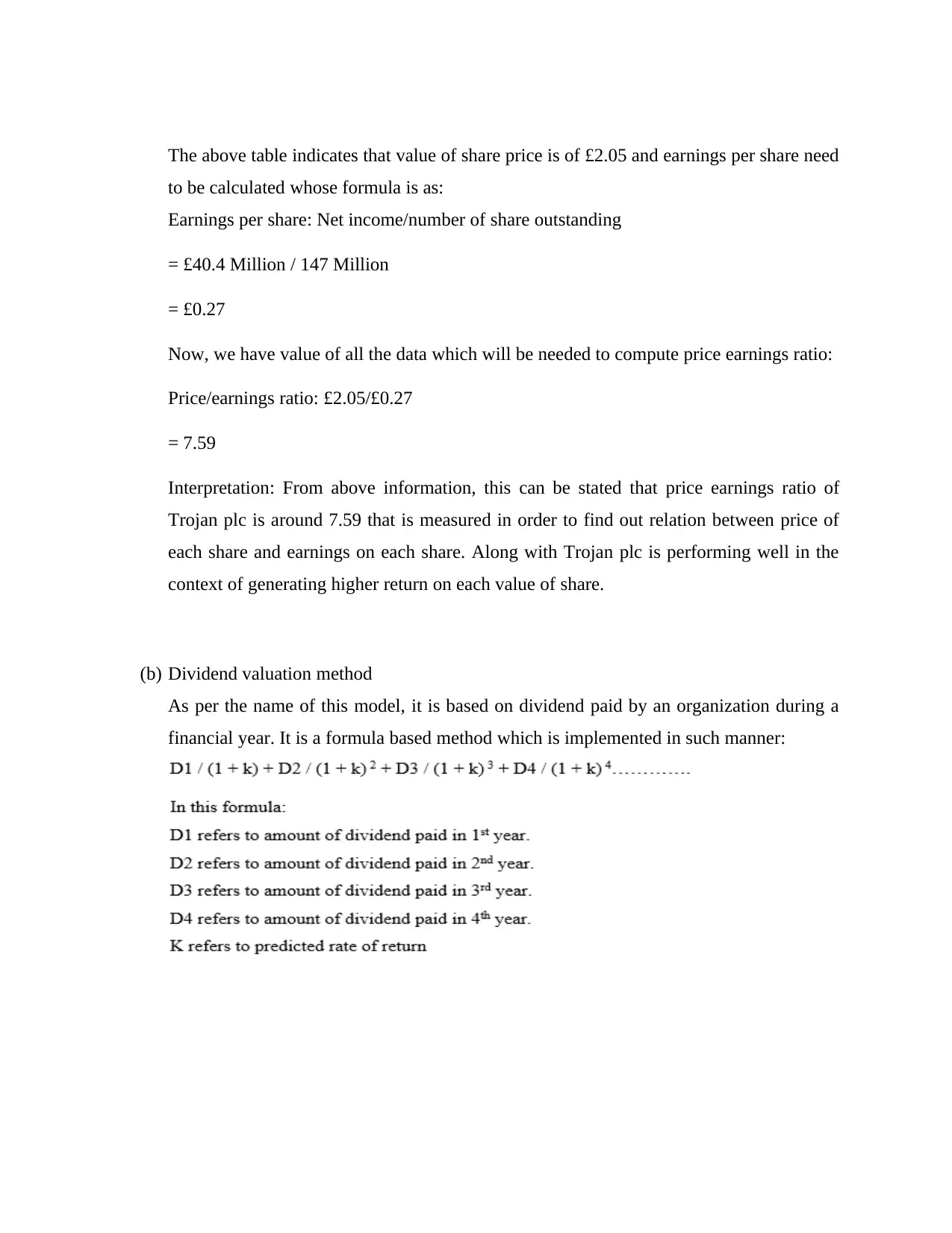
The above table indicates that value of share price is of £2.05 and earnings per share need
to be calculated whose formula is as:
Earnings per share: Net income/number of share outstanding
= £40.4 Million / 147 Million
= £0.27
Now, we have value of all the data which will be needed to compute price earnings ratio:
Price/earnings ratio: £2.05/£0.27
= 7.59
Interpretation: From above information, this can be stated that price earnings ratio of
Trojan plc is around 7.59 that is measured in order to find out relation between price of
each share and earnings on each share. Along with Trojan plc is performing well in the
context of generating higher return on each value of share.
(b) Dividend valuation method
As per the name of this model, it is based on dividend paid by an organization during a
financial year. It is a formula based method which is implemented in such manner:
to be calculated whose formula is as:
Earnings per share: Net income/number of share outstanding
= £40.4 Million / 147 Million
= £0.27
Now, we have value of all the data which will be needed to compute price earnings ratio:
Price/earnings ratio: £2.05/£0.27
= 7.59
Interpretation: From above information, this can be stated that price earnings ratio of
Trojan plc is around 7.59 that is measured in order to find out relation between price of
each share and earnings on each share. Along with Trojan plc is performing well in the
context of generating higher return on each value of share.
(b) Dividend valuation method
As per the name of this model, it is based on dividend paid by an organization during a
financial year. It is a formula based method which is implemented in such manner:
Paraphrase This Document
Need a fresh take? Get an instant paraphrase of this document with our AI Paraphraser
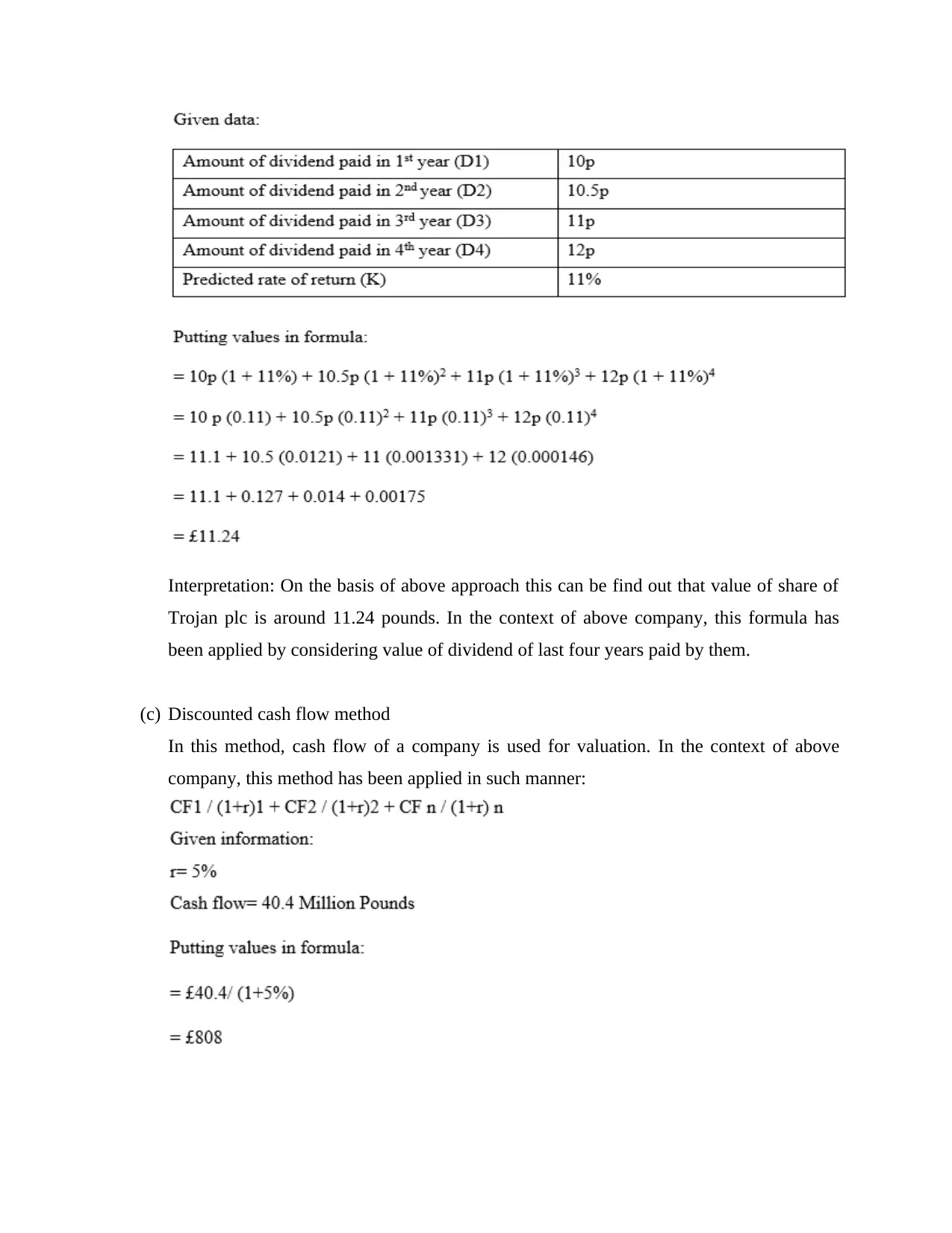
Interpretation: On the basis of above approach this can be find out that value of share of
Trojan plc is around 11.24 pounds. In the context of above company, this formula has
been applied by considering value of dividend of last four years paid by them.
(c) Discounted cash flow method
In this method, cash flow of a company is used for valuation. In the context of above
company, this method has been applied in such manner:
Trojan plc is around 11.24 pounds. In the context of above company, this formula has
been applied by considering value of dividend of last four years paid by them.
(c) Discounted cash flow method
In this method, cash flow of a company is used for valuation. In the context of above
company, this method has been applied in such manner:
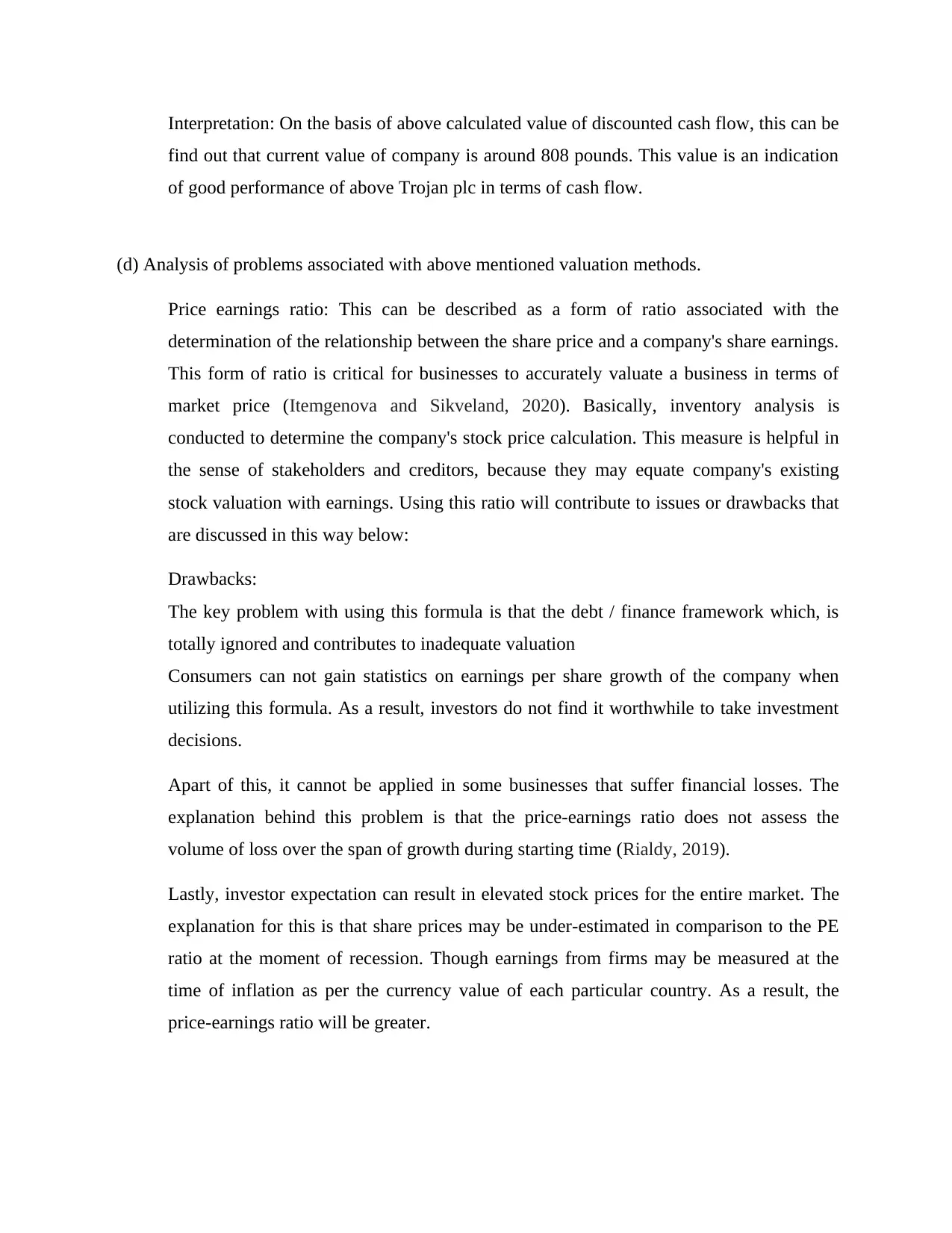
Interpretation: On the basis of above calculated value of discounted cash flow, this can be
find out that current value of company is around 808 pounds. This value is an indication
of good performance of above Trojan plc in terms of cash flow.
(d) Analysis of problems associated with above mentioned valuation methods.
Price earnings ratio: This can be described as a form of ratio associated with the
determination of the relationship between the share price and a company's share earnings.
This form of ratio is critical for businesses to accurately valuate a business in terms of
market price (Itemgenova and Sikveland, 2020). Basically, inventory analysis is
conducted to determine the company's stock price calculation. This measure is helpful in
the sense of stakeholders and creditors, because they may equate company's existing
stock valuation with earnings. Using this ratio will contribute to issues or drawbacks that
are discussed in this way below:
Drawbacks:
The key problem with using this formula is that the debt / finance framework which, is
totally ignored and contributes to inadequate valuation
Consumers can not gain statistics on earnings per share growth of the company when
utilizing this formula. As a result, investors do not find it worthwhile to take investment
decisions.
Apart of this, it cannot be applied in some businesses that suffer financial losses. The
explanation behind this problem is that the price-earnings ratio does not assess the
volume of loss over the span of growth during starting time (Rialdy, 2019).
Lastly, investor expectation can result in elevated stock prices for the entire market. The
explanation for this is that share prices may be under-estimated in comparison to the PE
ratio at the moment of recession. Though earnings from firms may be measured at the
time of inflation as per the currency value of each particular country. As a result, the
price-earnings ratio will be greater.
find out that current value of company is around 808 pounds. This value is an indication
of good performance of above Trojan plc in terms of cash flow.
(d) Analysis of problems associated with above mentioned valuation methods.
Price earnings ratio: This can be described as a form of ratio associated with the
determination of the relationship between the share price and a company's share earnings.
This form of ratio is critical for businesses to accurately valuate a business in terms of
market price (Itemgenova and Sikveland, 2020). Basically, inventory analysis is
conducted to determine the company's stock price calculation. This measure is helpful in
the sense of stakeholders and creditors, because they may equate company's existing
stock valuation with earnings. Using this ratio will contribute to issues or drawbacks that
are discussed in this way below:
Drawbacks:
The key problem with using this formula is that the debt / finance framework which, is
totally ignored and contributes to inadequate valuation
Consumers can not gain statistics on earnings per share growth of the company when
utilizing this formula. As a result, investors do not find it worthwhile to take investment
decisions.
Apart of this, it cannot be applied in some businesses that suffer financial losses. The
explanation behind this problem is that the price-earnings ratio does not assess the
volume of loss over the span of growth during starting time (Rialdy, 2019).
Lastly, investor expectation can result in elevated stock prices for the entire market. The
explanation for this is that share prices may be under-estimated in comparison to the PE
ratio at the moment of recession. Though earnings from firms may be measured at the
time of inflation as per the currency value of each particular country. As a result, the
price-earnings ratio will be greater.
⊘ This is a preview!⊘
Do you want full access?
Subscribe today to unlock all pages.

Trusted by 1+ million students worldwide
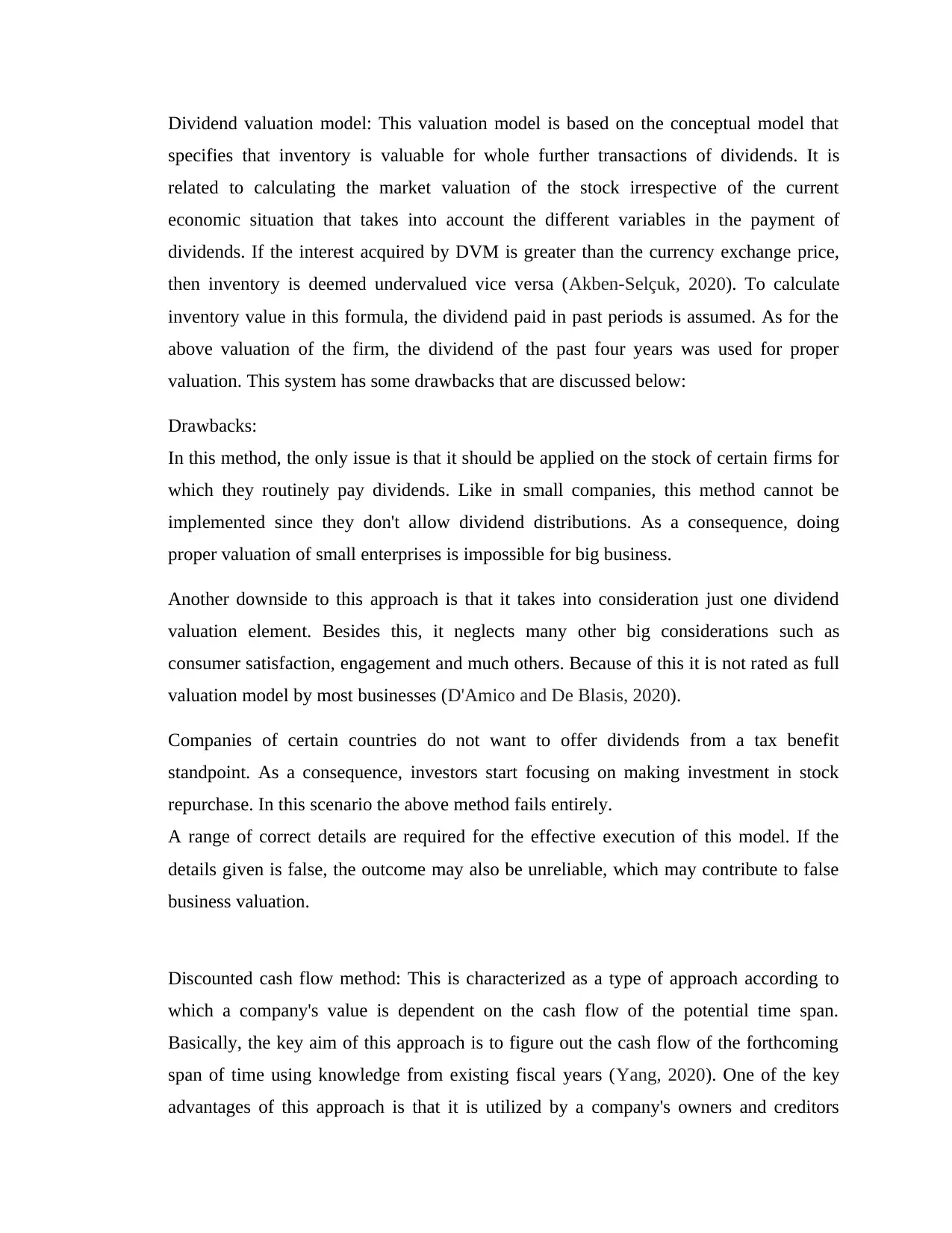
Dividend valuation model: This valuation model is based on the conceptual model that
specifies that inventory is valuable for whole further transactions of dividends. It is
related to calculating the market valuation of the stock irrespective of the current
economic situation that takes into account the different variables in the payment of
dividends. If the interest acquired by DVM is greater than the currency exchange price,
then inventory is deemed undervalued vice versa (Akben-Selçuk, 2020). To calculate
inventory value in this formula, the dividend paid in past periods is assumed. As for the
above valuation of the firm, the dividend of the past four years was used for proper
valuation. This system has some drawbacks that are discussed below:
Drawbacks:
In this method, the only issue is that it should be applied on the stock of certain firms for
which they routinely pay dividends. Like in small companies, this method cannot be
implemented since they don't allow dividend distributions. As a consequence, doing
proper valuation of small enterprises is impossible for big business.
Another downside to this approach is that it takes into consideration just one dividend
valuation element. Besides this, it neglects many other big considerations such as
consumer satisfaction, engagement and much others. Because of this it is not rated as full
valuation model by most businesses (D'Amico and De Blasis, 2020).
Companies of certain countries do not want to offer dividends from a tax benefit
standpoint. As a consequence, investors start focusing on making investment in stock
repurchase. In this scenario the above method fails entirely.
A range of correct details are required for the effective execution of this model. If the
details given is false, the outcome may also be unreliable, which may contribute to false
business valuation.
Discounted cash flow method: This is characterized as a type of approach according to
which a company's value is dependent on the cash flow of the potential time span.
Basically, the key aim of this approach is to figure out the cash flow of the forthcoming
span of time using knowledge from existing fiscal years (Yang, 2020). One of the key
advantages of this approach is that it is utilized by a company's owners and creditors
specifies that inventory is valuable for whole further transactions of dividends. It is
related to calculating the market valuation of the stock irrespective of the current
economic situation that takes into account the different variables in the payment of
dividends. If the interest acquired by DVM is greater than the currency exchange price,
then inventory is deemed undervalued vice versa (Akben-Selçuk, 2020). To calculate
inventory value in this formula, the dividend paid in past periods is assumed. As for the
above valuation of the firm, the dividend of the past four years was used for proper
valuation. This system has some drawbacks that are discussed below:
Drawbacks:
In this method, the only issue is that it should be applied on the stock of certain firms for
which they routinely pay dividends. Like in small companies, this method cannot be
implemented since they don't allow dividend distributions. As a consequence, doing
proper valuation of small enterprises is impossible for big business.
Another downside to this approach is that it takes into consideration just one dividend
valuation element. Besides this, it neglects many other big considerations such as
consumer satisfaction, engagement and much others. Because of this it is not rated as full
valuation model by most businesses (D'Amico and De Blasis, 2020).
Companies of certain countries do not want to offer dividends from a tax benefit
standpoint. As a consequence, investors start focusing on making investment in stock
repurchase. In this scenario the above method fails entirely.
A range of correct details are required for the effective execution of this model. If the
details given is false, the outcome may also be unreliable, which may contribute to false
business valuation.
Discounted cash flow method: This is characterized as a type of approach according to
which a company's value is dependent on the cash flow of the potential time span.
Basically, the key aim of this approach is to figure out the cash flow of the forthcoming
span of time using knowledge from existing fiscal years (Yang, 2020). One of the key
advantages of this approach is that it is utilized by a company's owners and creditors
Paraphrase This Document
Need a fresh take? Get an instant paraphrase of this document with our AI Paraphraser
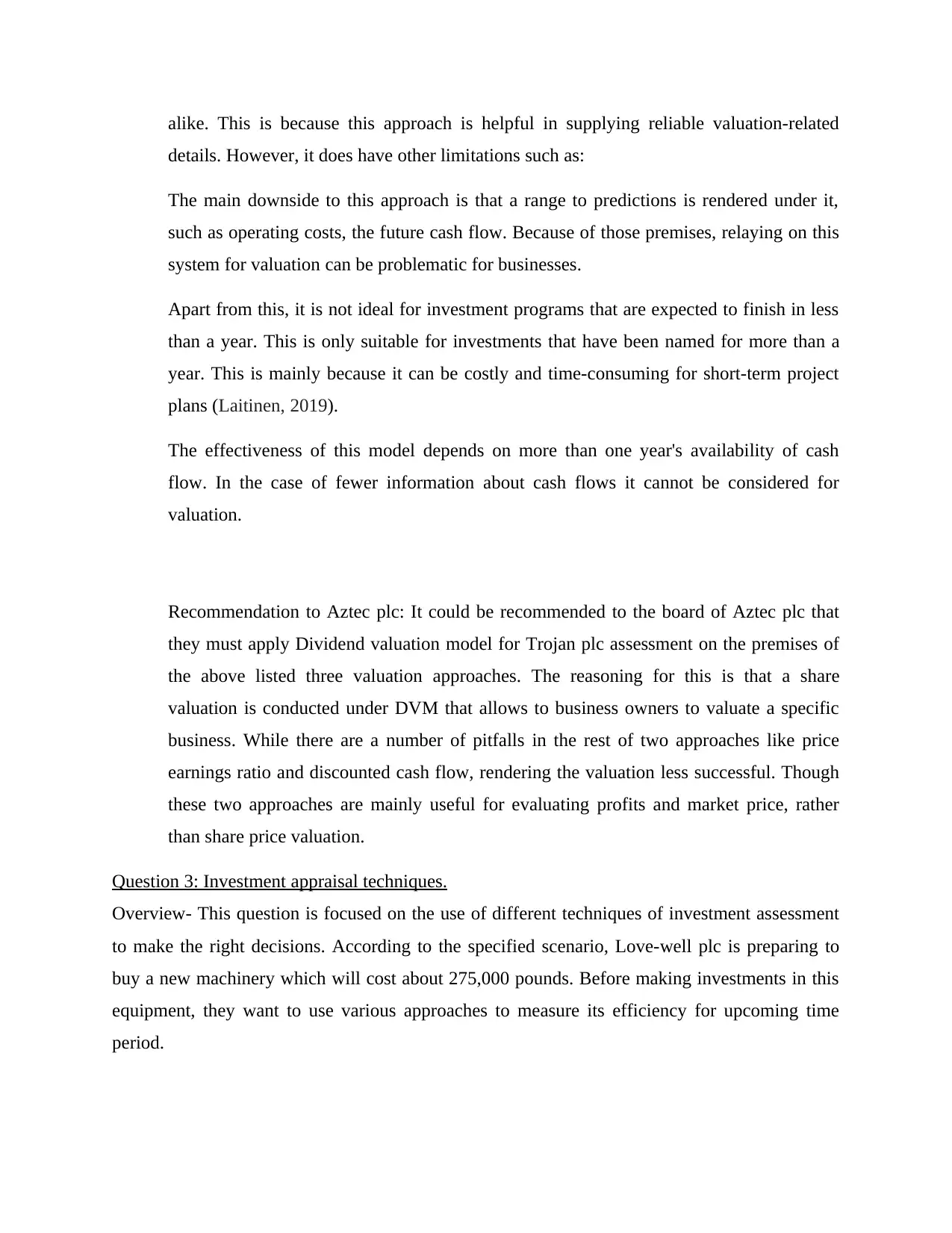
alike. This is because this approach is helpful in supplying reliable valuation-related
details. However, it does have other limitations such as:
The main downside to this approach is that a range to predictions is rendered under it,
such as operating costs, the future cash flow. Because of those premises, relaying on this
system for valuation can be problematic for businesses.
Apart from this, it is not ideal for investment programs that are expected to finish in less
than a year. This is only suitable for investments that have been named for more than a
year. This is mainly because it can be costly and time-consuming for short-term project
plans (Laitinen, 2019).
The effectiveness of this model depends on more than one year's availability of cash
flow. In the case of fewer information about cash flows it cannot be considered for
valuation.
Recommendation to Aztec plc: It could be recommended to the board of Aztec plc that
they must apply Dividend valuation model for Trojan plc assessment on the premises of
the above listed three valuation approaches. The reasoning for this is that a share
valuation is conducted under DVM that allows to business owners to valuate a specific
business. While there are a number of pitfalls in the rest of two approaches like price
earnings ratio and discounted cash flow, rendering the valuation less successful. Though
these two approaches are mainly useful for evaluating profits and market price, rather
than share price valuation.
Question 3: Investment appraisal techniques.
Overview- This question is focused on the use of different techniques of investment assessment
to make the right decisions. According to the specified scenario, Love-well plc is preparing to
buy a new machinery which will cost about 275,000 pounds. Before making investments in this
equipment, they want to use various approaches to measure its efficiency for upcoming time
period.
details. However, it does have other limitations such as:
The main downside to this approach is that a range to predictions is rendered under it,
such as operating costs, the future cash flow. Because of those premises, relaying on this
system for valuation can be problematic for businesses.
Apart from this, it is not ideal for investment programs that are expected to finish in less
than a year. This is only suitable for investments that have been named for more than a
year. This is mainly because it can be costly and time-consuming for short-term project
plans (Laitinen, 2019).
The effectiveness of this model depends on more than one year's availability of cash
flow. In the case of fewer information about cash flows it cannot be considered for
valuation.
Recommendation to Aztec plc: It could be recommended to the board of Aztec plc that
they must apply Dividend valuation model for Trojan plc assessment on the premises of
the above listed three valuation approaches. The reasoning for this is that a share
valuation is conducted under DVM that allows to business owners to valuate a specific
business. While there are a number of pitfalls in the rest of two approaches like price
earnings ratio and discounted cash flow, rendering the valuation less successful. Though
these two approaches are mainly useful for evaluating profits and market price, rather
than share price valuation.
Question 3: Investment appraisal techniques.
Overview- This question is focused on the use of different techniques of investment assessment
to make the right decisions. According to the specified scenario, Love-well plc is preparing to
buy a new machinery which will cost about 275,000 pounds. Before making investments in this
equipment, they want to use various approaches to measure its efficiency for upcoming time
period.
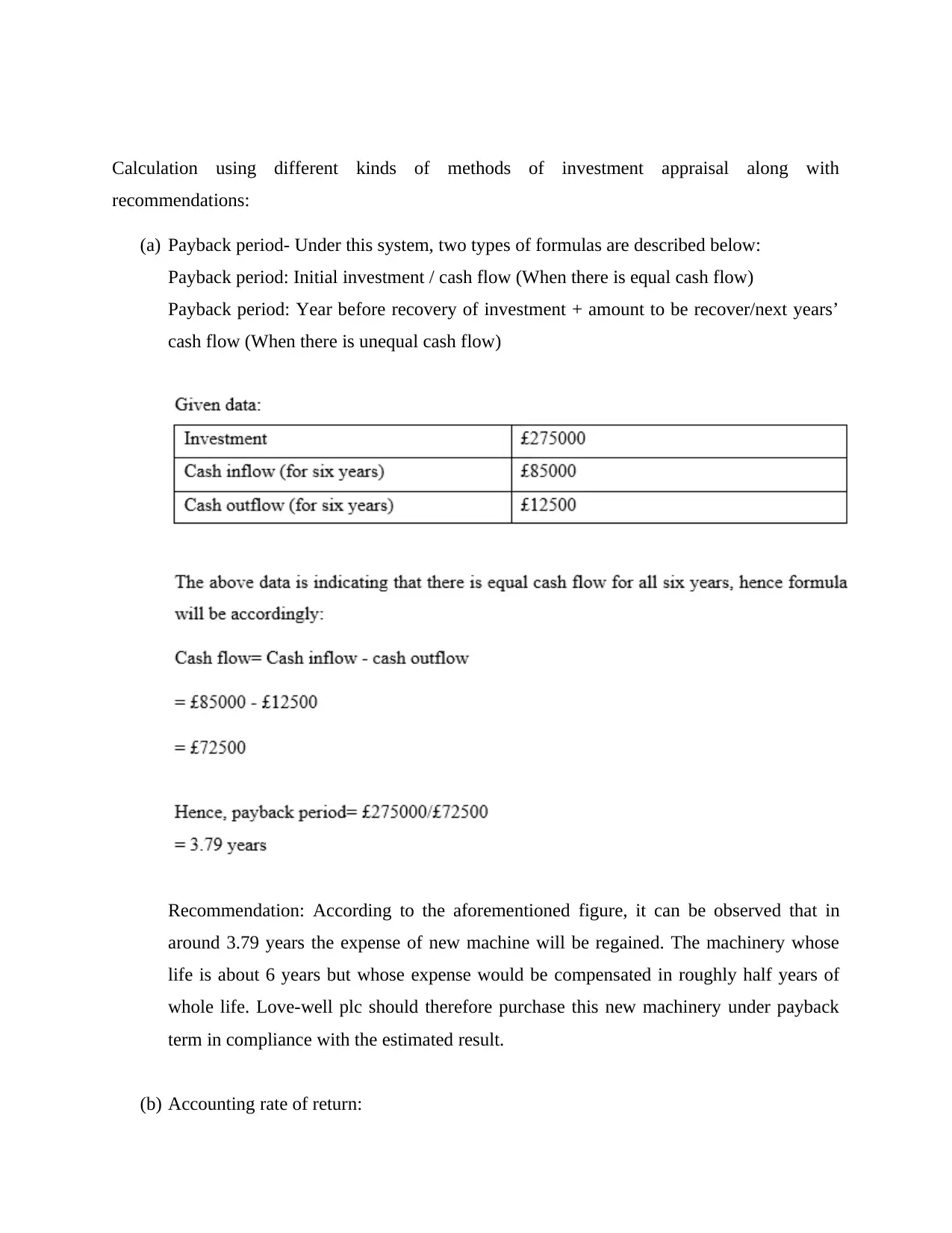
Calculation using different kinds of methods of investment appraisal along with
recommendations:
(a) Payback period- Under this system, two types of formulas are described below:
Payback period: Initial investment / cash flow (When there is equal cash flow)
Payback period: Year before recovery of investment + amount to be recover/next years’
cash flow (When there is unequal cash flow)
Recommendation: According to the aforementioned figure, it can be observed that in
around 3.79 years the expense of new machine will be regained. The machinery whose
life is about 6 years but whose expense would be compensated in roughly half years of
whole life. Love-well plc should therefore purchase this new machinery under payback
term in compliance with the estimated result.
(b) Accounting rate of return:
recommendations:
(a) Payback period- Under this system, two types of formulas are described below:
Payback period: Initial investment / cash flow (When there is equal cash flow)
Payback period: Year before recovery of investment + amount to be recover/next years’
cash flow (When there is unequal cash flow)
Recommendation: According to the aforementioned figure, it can be observed that in
around 3.79 years the expense of new machine will be regained. The machinery whose
life is about 6 years but whose expense would be compensated in roughly half years of
whole life. Love-well plc should therefore purchase this new machinery under payback
term in compliance with the estimated result.
(b) Accounting rate of return:
⊘ This is a preview!⊘
Do you want full access?
Subscribe today to unlock all pages.

Trusted by 1+ million students worldwide
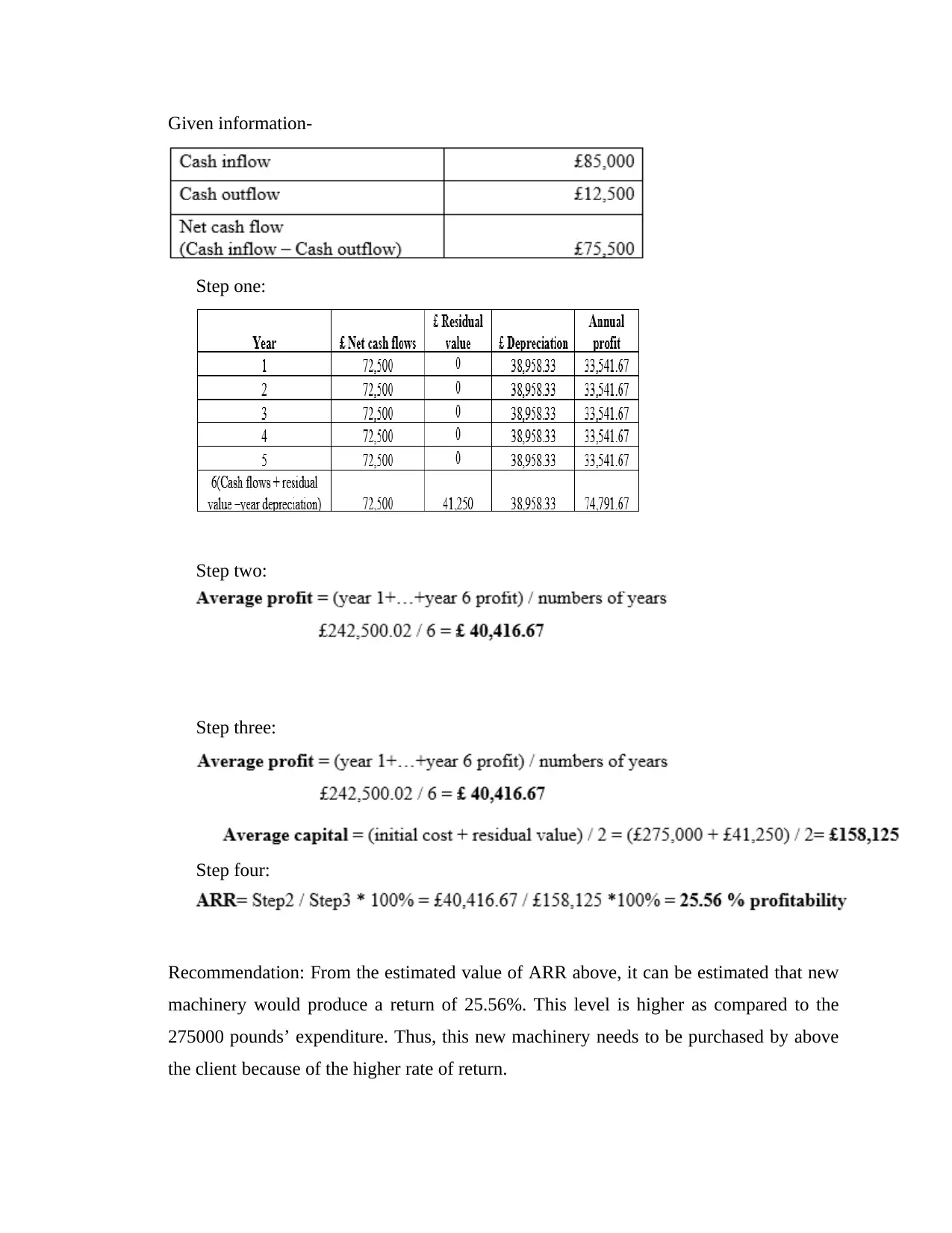
Given information-
Step one:
Step two:
Step three:
Step four:
Recommendation: From the estimated value of ARR above, it can be estimated that new
machinery would produce a return of 25.56%. This level is higher as compared to the
275000 pounds’ expenditure. Thus, this new machinery needs to be purchased by above
the client because of the higher rate of return.
Step one:
Step two:
Step three:
Step four:
Recommendation: From the estimated value of ARR above, it can be estimated that new
machinery would produce a return of 25.56%. This level is higher as compared to the
275000 pounds’ expenditure. Thus, this new machinery needs to be purchased by above
the client because of the higher rate of return.
Paraphrase This Document
Need a fresh take? Get an instant paraphrase of this document with our AI Paraphraser
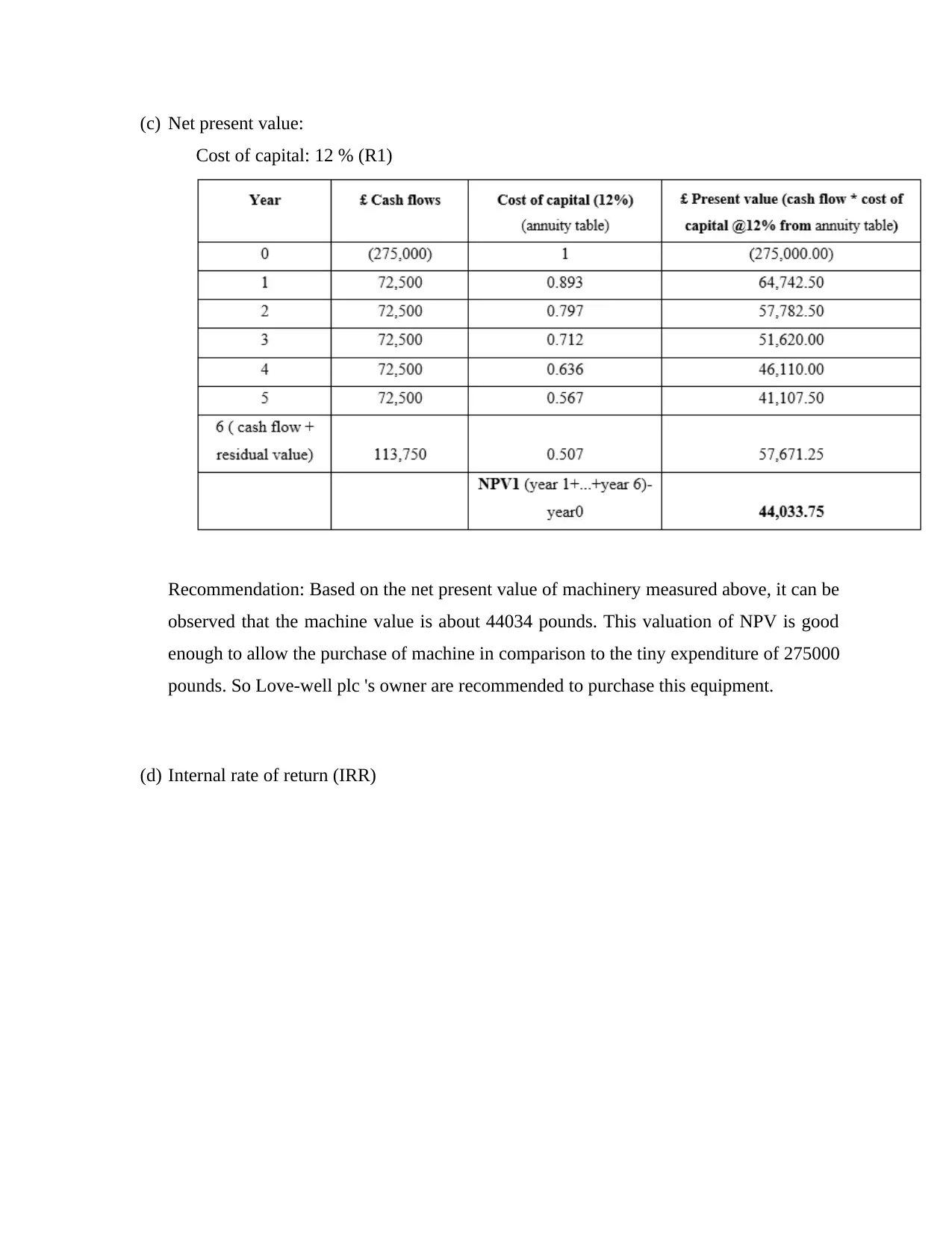
(c) Net present value:
Cost of capital: 12 % (R1)
Recommendation: Based on the net present value of machinery measured above, it can be
observed that the machine value is about 44034 pounds. This valuation of NPV is good
enough to allow the purchase of machine in comparison to the tiny expenditure of 275000
pounds. So Love-well plc 's owner are recommended to purchase this equipment.
(d) Internal rate of return (IRR)
Cost of capital: 12 % (R1)
Recommendation: Based on the net present value of machinery measured above, it can be
observed that the machine value is about 44034 pounds. This valuation of NPV is good
enough to allow the purchase of machine in comparison to the tiny expenditure of 275000
pounds. So Love-well plc 's owner are recommended to purchase this equipment.
(d) Internal rate of return (IRR)
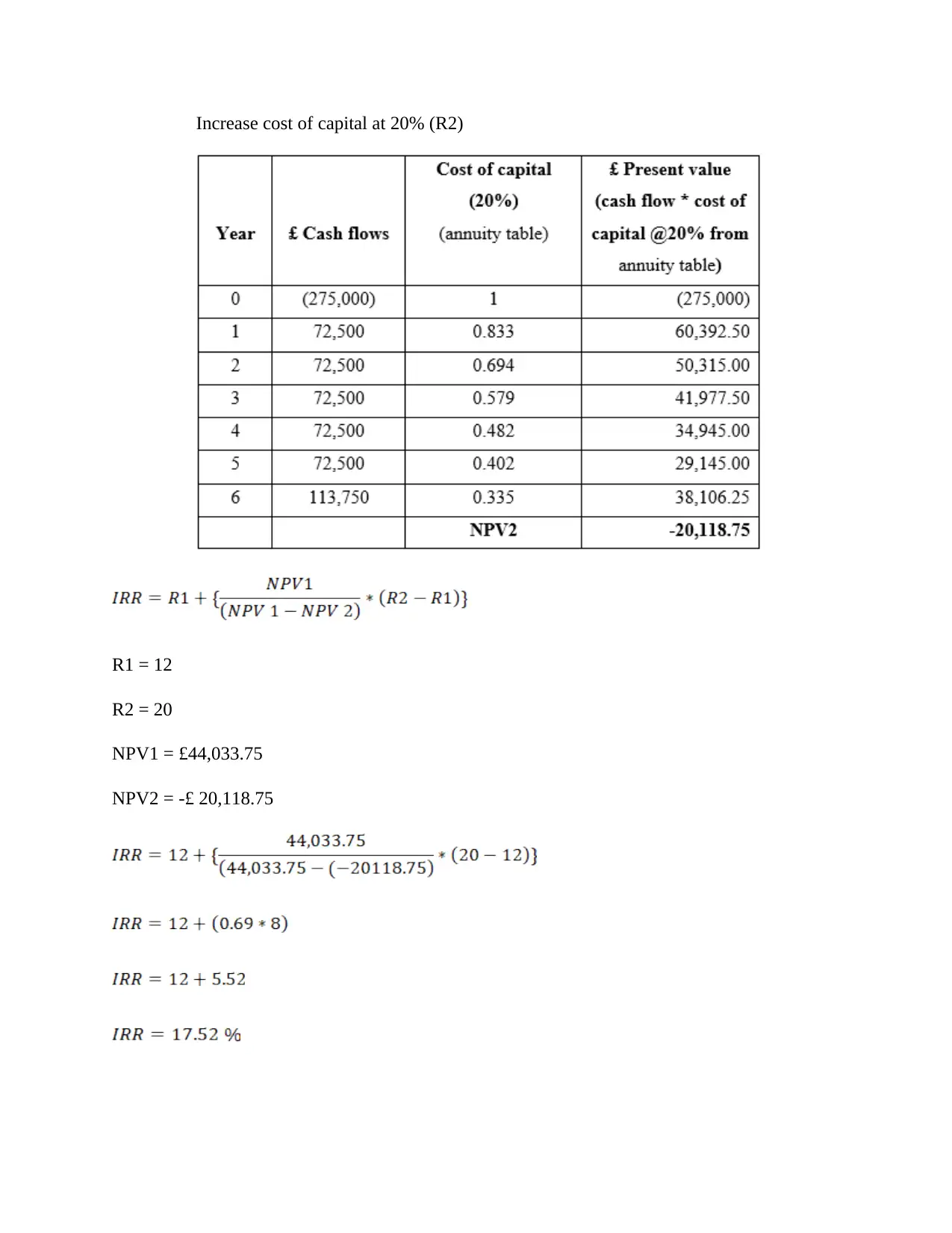
Increase cost of capital at 20% (R2)
R1 = 12
R2 = 20
NPV1 = £44,033.75
NPV2 = -£ 20,118.75
R1 = 12
R2 = 20
NPV1 = £44,033.75
NPV2 = -£ 20,118.75
⊘ This is a preview!⊘
Do you want full access?
Subscribe today to unlock all pages.

Trusted by 1+ million students worldwide
1 out of 17
Related Documents
Your All-in-One AI-Powered Toolkit for Academic Success.
+13062052269
info@desklib.com
Available 24*7 on WhatsApp / Email
![[object Object]](/_next/static/media/star-bottom.7253800d.svg)
Unlock your academic potential
Copyright © 2020–2025 A2Z Services. All Rights Reserved. Developed and managed by ZUCOL.





